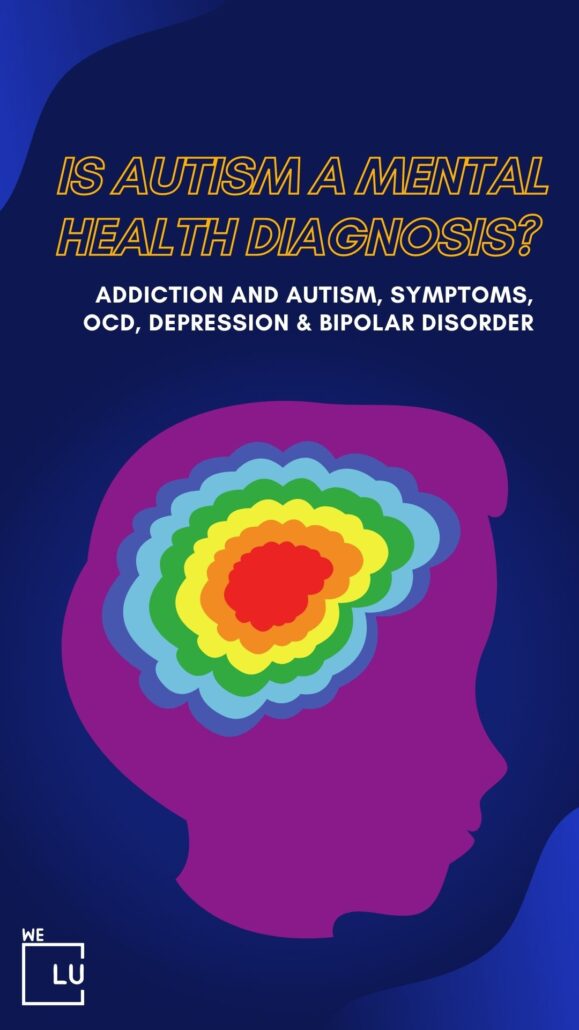ADHD vs Autism Overview
In a world encompassing a rich diversity of neurodiversity, two distinct but often intertwined conditions—ADHD (Attention-Deficit/Hyperactivity Disorder) and Autism—are subjects of growing interest and discussion. As we strive to understand the intricacies of these conditions, it becomes increasingly vital to discern the differences between them. While ADHD vs Autism can have some things in common, they also have things that make them different. The article addresses ADHD vs Autism, explaining the minor differences between ADHD and Autism. This makes it easier to understand these conditions and helps people understand how complicated the mind is.
What are ADHD and Autism?
ADHD (Attention-Deficit/Hyperactivity Disorder) and Autism are both neurodevelopmental disorders that affect how individuals interact with the world and process information but manifest in distinct ways.
ADHD is characterized by difficulty maintaining attention, controlling impulses, and regulating hyperactivity. Individuals with ADHD often struggle with focusing on tasks, following instructions, and staying organized. They might be prone to impulsive behaviors and have trouble sitting still or waiting their turn. ADHD can be categorized into three types: predominantly inattentive, predominantly hyperactive-impulsive, and combined presentation.
Autism, on the other hand, is a broader spectrum disorder known as Autism Spectrum Disorder (ASD). It encompasses various symptoms and behaviors, including social communication, interaction challenges, and restricted and repetitive behaviors. People with Autism might have difficulty understanding social cues, expressing emotions, and forming relationships. The spectrum nature of Autism means that individuals can experience varying degrees of impairment in different areas, leading to a diverse array of strengths and challenges.
In summary, while ADHD primarily involves attention difficulties and impulsivity, Autism is characterized by a more complex combination of social communication challenges and repetitive behaviors. Recognizing these differences is essential to provide appropriate support and interventions for individuals with either condition.


Skip To:
Learn More:
Symptoms of ADHD vs Autism
Navigating the distinctions between the symptoms of ADHD (Attention-Deficit/Hyperactivity Disorder) and Autism requires a nuanced understanding of their respective characteristics and impacts.
| ADHD Symptoms | Autism Symptoms |
|---|---|
| Difficulty sustaining attention | Impaired attention and focus |
| Acting without thinking (impulsivity) | Difficulty understanding social cues |
| Restlessness and excessive movement (hyperactivity) | Restricted and repetitive behaviors |
| Impulsivity in social situations | Challenges in social communication |
| Interrupting conversations and talking excessively | Difficulty expressing and reading emotions |
| Disliking routines and structure | Thriving on routines and predictability |
| Occasional sensory sensitivities | Common sensory sensitivities |
Ultimately, it’s essential to know these differences between ADHD and Autism signs so that a correct evaluation can be made and the proper treatment can be given. People’s experiences with each condition differ because of how it shows up. It’s important to understand these differences so that you can give them the right help and tactics that meet their needs.
Get Help. Get Better. Get Your Life Back.
Searching for Accredited Dual Diagnosis Mental Health Centers Near You?
Even if therapy failed previously, or are in the middle of a difficult crisis, we stand ready to support you. Our trusted behavioral health specialists will not give up on you. When you feel ready or just want someone to speak to about counseling alternatives to change your life call us. Even if we cannot assist you, we will lead you to wherever you can get support. There is no obligation. Call our hotline today.
FREE 24/7 Dual Diagnosis Mental Health Services HotlineADHD Fact Sheet
Prevalence: ADHD is one of the most common neurodevelopmental disorders, affecting approximately 5-10% of children and 2-5% of adults worldwide. It is more commonly diagnosed in males than females.
Core Symptoms: The core symptoms of ADHD include inattention, hyperactivity, and impulsivity. Individuals with ADHD may have difficulty sustaining attention, organizing tasks, following instructions, sitting still, and controlling impulses.
ADHD is categorized into three subtypes:
a. Predominantly Inattentive Presentation: Primarily characterized by difficulties with attention and organization.
b. Predominantly Hyperactive-Impulsive Presentation: Primarily characterized by hyperactivity and impulsivity.
c. Combined Presentation: Displays symptoms of both inattention and hyperactivity-impulsivity.
Diagnosis of ADHD: This involves a comprehensive evaluation, including interviews with the individual, parents (for children), and teachers or other relevant observers. The Diagnostic and Statistical Manual of Mental Disorders (DSM-5) criteria are commonly used for diagnosis.
Long-Term Outlook: With appropriate diagnosis, treatment, and support, individuals with ADHD can lead fulfilling lives. Early intervention and ongoing management can significantly reduce the impact of symptoms and improve overall functioning.
Co-occurring Conditions: ADHD often coexists with other conditions such as learning disabilities, anxiety disorders, depression, oppositional defiant disorder (ODD), and conduct disorder (CD). These comorbidities can further complicate diagnosis and treatment.
ADHD Statistics
Attention Deficit Hyperactivity Disorder (ADHD) is a neurological condition affecting millions worldwide. While it has gained increasing recognition over the years, the prevalence and impact of ADHD remain substantial. Delving into the statistics provides us with a clearer picture of the scope of this condition, its demographic patterns, and the challenges it poses to individuals, families, and communities.
- Prevalence Rates: ADHD affects 5-10% of children and 2-5% of adults in the US, with varying rates worldwide (1-20%).
- Gender Distribution: Historically seen more in males, ADHD impacts all genders, sometimes differently.
- Age-related Patterns: ADHD persists into adulthood for many, presenting distinct challenges in education, work, and relationships.
- Comorbidity: ADHD often coexists with anxiety, depression, and learning disabilities.
- Socio-economic Implications: ADHD entails higher healthcare and education costs, affecting families and individuals.
8.7 Million
In 2019, the number of visits to physician offices with attention deficit disorder as the primary diagnosis was 8.7 million.
Source: NIMH
9.5%
Approximately 9.5% of American adults, ages 18 and over, will suffer from a depressive illness (major depression, bipolar disorder, or dysthymia) each year.
Source: NIMH
70-80%
The heritability of ADHD, estimated to be around 70-80%, further supports the notion that genetic factors play a substantial role in its development.
Source: NIMH
Distinguishing ADHD and Autism
ADHD and Autism are distinct entities within the realm of neurodevelopmental conditions. ADHD centers on attention and impulsivity, while Autism revolves around social communication challenges and repetitive behaviors. Recognizing these disparities is essential for accurate identification, appropriate interventions, and understanding the unique needs of individuals navigating their paths within the context of ADHD or Autism.
- Accurate Diagnosis: Tailored interventions based on accurate identification.
- Effective Treatment: Targeted therapies for specific challenges.
- Personalized Support: Customized strategies for individuals’ needs.
- Improved Communication: Informed interactions with empathy.
- Reduced Stigma: Dispelling misconceptions and fostering acceptance.
- Research Advancement: Better insights leading to innovative solutions.
- Enhanced Advocacy: Policies aligned with specific needs.
- Quality of Life: Improved coping, interactions, and overall well-being.
- Inclusive Education: Strategies catering to unique learning styles.
- Empowerment: Confidence for individuals and families navigating challenges.

Each condition’s unique manifestations shape individuals’ experiences, highlighting the importance of understanding these nuances to provide appropriate support and strategies that cater to their needs.

End the Emotional Pain. Get Your Life Back.
Feeling Depressed, Anxious or Struggling with Mental Health Illness? Get Safe Comfortable Mental Health Dual Diagnosis High-Quality Therapy From Counselors That Care. Begin Your Recovery Now.
Hotline (855) 940-6125Autism vs ADHD
ADHD (Attention-Deficit/Hyperactivity Disorder) and Autism are distinctive neurodevelopmental disorders, each with defining features and challenges. Although they can present certain overlapping traits, such as difficulties in social interactions and focus a closer examination reveals that these conditions are fundamentally distinct. Let’s delve into the contrasts between ADHD and Autism:
| Aspect | ADHD | Autism |
|---|---|---|
| Core Symptoms | Attention difficulties, impulsivity, hyperactivity | Social communication challenges, restricted and repetitive behaviors |
| Social Interaction | Impulsiveness in social situations | Profound difficulties in understanding social cues, forming relationships |
| Repetitive Behaviors | Not a hallmark of ADHD | Prominent repetitive behaviors, interests, routines |
| Sensory Sensitivities | Occasional sensitivities | Common sensory sensitivities |
| Diagnosis Approach | Focuses on attention difficulties and hyperactivity/impulsivity symptoms | Assesses social communication deficits and restricted/repetitive behaviors |
| Categorization | Subtypes: inattentive, hyperactive-impulsive, combined | Part of Autism Spectrum Disorder (ASD) continuum |
ADHD and Autism Overlap
The relationship between ADHD (Attention-Deficit/Hyperactivity Disorder) and Autism is complex and often marked by overlapping features. While these conditions have distinct diagnostic criteria, they can share certain traits that make differentiation challenging. Here’s a glimpse into the overlap between ADHD and Autism:
1. Social Interaction Challenges:
Both ADHD and Autism can involve difficulties in social interactions. Individuals with ADHD might struggle with impulsivity, leading to disruptions in conversations and interactions. Similarly, Autism is characterized by challenges in understanding social cues, manifesting as difficulties in forming relationships and engaging in reciprocal conversations.
2. Sensory Sensitivities:
Sensory sensitivities, although more prevalent in Autism, can also appear in individuals with ADHD. Some people with ADHD might have heightened or diminished reactions to sensory stimuli like noise, textures, or light.
3. Executive Function Deficits:
Both conditions can exhibit deficits in executive functions, which involve skills like planning, organizing, and inhibiting impulses. Individuals with ADHD might find it hard to manage tasks and regulate their behavior, while those with Autism might experience challenges in flexible thinking and adapting to change.
4. Impulsivity and Repetitive Behaviors:
Impulsivity, common in ADHD, can sometimes mirror the repetitive behaviors seen in Autism. While repetitive behaviors are more central to Autism, some individuals with ADHD might display certain habits or routines.
5. Coexistence:
The coexistence of ADHD and Autism is not uncommon. Some individuals may receive both diagnoses, highlighting the intricate relationship between these conditions.
Recognizing the overlap between ADHD and Autism underscores the importance of comprehensive assessments and individualized approaches to diagnosis and intervention. Professionals must consider the full spectrum of symptoms and traits, enabling accurate identification and tailored support that addresses each individual’s unique challenges and strengths.
ADHD Autism Comorbidity
The coexistence of ADHD (Attention-Deficit/Hyperactivity Disorder) and Autism, termed comorbidity, presents a multifaceted scenario that demands careful consideration. Comorbidity occurs when an individual carries both diagnoses simultaneously, blending the distinctive traits of each condition into a complex tapestry. Let’s delve into the realm of ADHD and Autism comorbidity:
1. Shared Traits Amplified: In cases of comorbidity, the shared traits of ADHD and Autism can become more pronounced. Impulsivity, attention difficulties, social interaction challenges, and sensory sensitivities may intertwine, creating a unique set of strengths and challenges.
2. Diagnostic Complexity: Identifying comorbidity requires astute evaluation, as the presence of one condition can mask or mimic symptoms of the other. Professionals must meticulously dissect the symptomatology to arrive at accurate conclusions.
3. Treatment Nuances: Comorbidity demands nuanced interventions that address the distinct aspects of both ADHD and Autism. Tailored strategies become essential, as a one-size-fits-all approach might not effectively address the intertwined symptoms.
4. Impact on Daily Life: Individuals with comorbid ADHD and Autism might encounter heightened difficulties in managing daily tasks, maintaining relationships, and navigating social situations due to the fusion of symptoms.
5. Individual Variability: The nature and intensity of comorbidity can vary significantly between individuals. Some may experience a more seamless blend of symptoms, while others might confront more contrasting manifestations.
Navigating ADHD and Autism comorbidity necessitates a comprehensive understanding of both conditions, their interplay, and how they shape an individual’s experiences.
First-class Facilities & Amenities
World-class High-Quality Mental Health Services & Behavioral Health Substance Abuse Treatment
Rehab Centers TourRenowned Mental Health Centers. Serene Private Facilities. Inpatient Rehab Programs Vary.
Mental Health Helpline (855) 940-6125Proven recovery success experience, backed by a Team w/ History of:
15+
Years of Unified Experience
100s
5-Star Reviews Across Our Centers
10K
Recovery Successes
- Comprehensive Dual-Diagnosis Treatment
- Complimentary Family & Alumni Programs
- Coaching, Recovery & Development Events
- Comfortable Onsite Medical Detox Center
Is ADHD on the Autism Spectrum?

The relationship between ADHD (Attention-Deficit/Hyperactivity Disorder) and Autism Spectrum Disorder (ASD) is often a topic of inquiry. While these conditions share certain overlapping traits, they are distinct in their core characteristics. ADHD primarily involves attention, impulse control, and hyperactivity challenges, often resulting in difficulty concentrating and self-regulation. On the other hand, Autism encompasses a broader spectrum of symptoms, including significant impairments in social communication and interaction and the presence of restricted and repetitive behaviors. While an individual can have both ADHD and Autism, they remain separate diagnoses. Some individuals with Autism may also exhibit ADHD-like symptoms, but the presence of these symptoms doesn’t necessarily imply that ADHD is on the Autism spectrum. Understanding these distinctions is essential for accurate diagnosis and appropriate interventions tailored to each individual’s needs.
Diagnosing ADHD and Autism
Diagnosing ADHD (Attention-Deficit/Hyperactivity Disorder) and Autism requires carefully examining symptoms, behaviors, and developmental history. These distinct neurodevelopmental conditions necessitate unique diagnostic processes, even though they can sometimes exhibit overlapping traits. Here’s a closer look at the pathways to diagnosing ADHD and Autism:
| Diagnosing ADHD | Diagnosing Autism |
|---|---|
| Symptom Assessment: | Social Communication Assessment: |
| Evaluate inattention, hyperactivity, impulsivity symptoms | Assess deficits in social communication and interaction |
| Observation and Interviews: | Restricted and Repetitive Behaviors: |
| Input from caregivers, teachers, and observers | Evaluate presence of restricted interests and repetitive behaviors |
| Questionnaires: | Behavioral Observations: |
| Use standardized questionnaires to assess symptom severity | Observe behavior and interactions in various contexts |
| Developmental Considerations: | Diagnostic Tools: |
| Evaluate the presence of restricted interests and repetitive behaviors | Utilize structured interviews and questionnaires |
| Rule-Out Criteria: | Developmental History: |
| Exclude other conditions with similar symptoms | Consider developmental milestones and challenges |
In both cases, a comprehensive approach is necessary to differentiate between ADHD and Autism. Professionals, often including psychologists, psychiatrists, and pediatricians, assess various factors to make an accurate diagnosis. Recognizing each condition’s specific criteria and characteristics is pivotal for providing appropriate interventions and support that address the unique needs of individuals with ADHD or Autism.
Autism and ADHD Together Symptoms
When Autism and ADHD (Attention-Deficit/Hyperactivity Disorder) coexist in an individual, their symptoms intertwine, creating a unique amalgamation that requires careful consideration. Here’s an exploration of the combined symptoms seen when Autism and ADHD are present together:
1. Attention Difficulties: Individuals with both Autism and ADHD may experience challenges in sustaining attention. Their attention spans might be shorter, leading to difficulty focusing on tasks and activities.
2. Impulsivity and Social Interaction: Impulsivity, a hallmark of ADHD, can manifest in social interactions for those with Autism and ADHD together. This might result in abrupt remarks, difficulties in turn-taking during conversations, and impulsive actions in social contexts.
3. Hyperactivity and Repetitive Behaviors: Hyperactivity in ADHD may blend with the repetitive behaviors seen in Autism. Individuals might engage in both hyperactive movements and repetitive actions or rituals.
4. Social Communication Challenges: Autism’s social communication deficits can be amplified by the impulsive communication style of ADHD. This could lead to difficulties in comprehending social cues and reciprocating appropriately.
5. Emotional Regulation: Emotional regulation challenges might emerge as a combination of both conditions. ADHD’s impulsivity could compound the difficulty in expressing emotions and understanding others’ feelings.
6. Sensory Sensitivities: Sensory sensitivities common in Autism can intertwine with ADHD, potentially leading to heightened reactions to sensory stimuli, such as noises or textures.
7. Task Management and Organizational Difficulties: Executive function deficits from both conditions might result in challenges with organizing tasks, managing time, and planning activities.
Recognizing and addressing the combined symptoms of Autism and ADHD necessitates a comprehensive approach. Tailored interventions and strategies should consider the intricate interplay of these symptoms, addressing both conditions’ distinct characteristics to provide holistic support that optimizes an individual’s functioning and quality of life.
ADHD Meltdown vs Autism Meltdown
An ADHD and Autism meltdown are two distinct phenomena, each stemming from different triggers and manifesting in unique ways. An ADHD meltdown is often triggered by sensory overload, emotional stress, or frustration. During such episodes, individuals with ADHD might exhibit impulsive and agitated behaviors, struggling to regulate emotions and reactions. On the other hand, an Autism meltdown typically arises from sensory sensitivities, changes in routine, or overwhelming stimuli. Those experiencing an Autism meltdown might display intense distress, repetitive behaviors, and difficulties communicating or coping with the sensory overload. Recognizing the specific triggers and responses associated with each type of meltdown is crucial for providing appropriate support and interventions tailored to the individual’s needs.
World-class, Accredited, 5-Star Reviewed, Effective Mental Health Dual Diagnosis Programs. Complete Integrated Inpatient Rehab with Free Post Discharge Therapy Planning.
CALL (855) 940-6125End the Emotional Pain Rollercoaster. Gain Stability & Happiness Through Recovery Treatment. Start Mental Health Counseling Today. Get Free No-obligation Guidance by Behaviroal Health Specialists Who Understand Mental Health Recovery.
Is ADHD a Form of Autism?
No, ADHD (Attention-Deficit/Hyperactivity Disorder) is not a form of Autism. While these two neurodevelopmental conditions share specific characteristics and can sometimes exhibit overlapping traits, they are distinct diagnoses with their specific criteria and features.
ADHD primarily involves challenges related to attention, impulse control, and hyperactivity. Individuals with ADHD often struggle with maintaining focus, acting impulsively, and may have difficulty sitting still or waiting their turn.
Autism, on the other hand, is characterized by difficulties in social communication and interaction and restricted and repetitive behaviors. People with Autism might have challenges understanding social cues, expressing emotions, and forming relationships.
Treatments for both conditions involve a combination of therapies, interventions, and, in some cases, medication. Tailored approaches are essential.

Autism and ADHD in Women
The intersection of Autism and ADHD (Attention-Deficit/Hyperactivity Disorder) in women adds a unique layer to understanding these neurodevelopmental conditions. Historically studied predominantly in males, the presentation of Autism and ADHD in women often differs, leading to challenges in identification and support. Here’s a closer look at how these conditions manifest in women:
| Autism in Women | ADHD in Women |
|---|---|
| Social Masking: | Inattentive Presentation: |
| Adept at mimicking social behaviors, leading to delayed diagnosis | Predominantly inattentive subtype might go unnoticed |
| Sensory Sensitivities: | Internalized Struggles: |
| Manifest differently, leading to internal struggles | Symptoms may manifest internally, affecting organization and time management |
| Interests and Behaviors: | Emotional Regulation: |
| Display different restricted interests and behaviors | Emotional regulation difficulties leading to mood swings and anxiety |
| Social Relationships: | Impulsivity: |
| Nuanced challenges in forming and maintaining friendships | Impulsivity manifests differently, impacting decision-making and relationships |
| Camouflaging: | Diagnostic Bias: |
| Camouflage social difficulties by imitating cues | Underdiagnosis due to diagnostic criteria based on male presentations |
Navigating the complexities of Autism and ADHD in women requires a gender-informed perspective. Understanding the unique ways these conditions manifest can facilitate earlier diagnosis, appropriate interventions, and tailored support that recognizes the specific strengths and challenges women bring to the table.
Autism and ADHD Together in Adults
When Autism and ADHD (Attention-Deficit/Hyperactivity Disorder) coexist in adults, their interaction creates a unique landscape of challenges and strengths. Exploring the interplay between these conditions in adulthood provides insights into individuals’ complexities. Here’s a closer look at the experience of living with Autism and ADHD simultaneously:
- Multifaceted Symptom Interaction:
- Symptoms include attention difficulties, impulsivity, social challenges, and repetitive behaviors.
- Varied symptom intensity highlights the dynamic interaction between the conditions.
- Social Interaction Complexity:
- Amplified social difficulties impact forming relationships, understanding cues, and managing impulsivity.
- Misreading cues can strain interactions and relationships.
- Sensory Sensitivities and Function:
- Combining sensory sensitivities from Autism with executive function deficits from ADHD.
- Overwhelming and task management challenges contribute to stress.
- Emotion Regulation and Coping:
- Emotional regulation difficulties from both conditions lead to mood changes and anxiety.
- Coping strategies manage sensory sensitivities and emotional challenges.
- Hyperfocus and Strengths:
- Hyperfocus from ADHD combines with an intense interest in Autism.
- Resulting strengths include creativity, deep thinking, and diverse perspectives.
Balancing the unique challenges and strengths of Autism and ADHD in adulthood requires tailored strategies. Recognizing the intertwined nature of symptoms, emotions, and strengths empowers individuals to navigate life’s intricacies with resilience and insight.
Experience Transformative Recovery at the We Level Up Treatment Center.
See our authentic success stories. Get inspired. Get the help you deserve.



Start a New Life
Begin with a free call to a behavioral health treatment advisor. Learn more about our dual-diagnosis programs. The We Level Up treatment center network delivers recovery programs that vary by each treatment facility. Call to learn more.
- Personalized Care
- Caring Accountable Staff
- World-class Amenities
- Licensed & Accredited
- Renowned w/ 5-Star Reviews
We’ll Call You
Popular ADHD vs Autism FAQs
-
Can You Have ADHD and Autism?
Yes, an individual can have both ADHD and Autism. This is known as comorbidity, where two or more conditions coexist.
-
Do I Have ADHD or Autism?
ADHD is diagnosed based on attention-related symptoms, while Autism diagnosis involves assessing social communication deficits and restricted behaviors.
-
Can ADHD cause Autism or vice versa?
No, ADHD does not cause Autism, and vice versa. They are separate conditions with their origins and developmental pathways.
8 Steps & Tips for Maintaining Your Mental Wellbeing Informative Video
Video Script
We at We Level Up FL are dedicated to personalized mental health services tailored to each person’s unique needs. Our experienced team collaborates closely with clients to create therapy programs that address their challenges and align with their goals. With empathy and support, we empower individuals to take an active role in their mental health journey by providing tools and strategies. We encourage exploration, self-discovery, and growth in a safe and nurturing environment. We understand that everyone is different, so we listen attentively and develop customized therapy plans based on individual concerns, strengths, and aspirations.
Search Drug & Alcohol Rehab / Detox & Mental Health ADHD vs Autism. What are the Differences? ADHD and Autism Topics & Resources
Sources
[1] What is ADHD? | CDC Examining ADD vs ADHD
[2] NIMH » Mental Illness (nih.gov) ADD vs ADHD Review
[3] NIMH » Attention-Deficit/Hyperactivity Disorder (ADHD) (nih.gov)
[4] Attention Deficit Hyperactivity Disorder – StatPearls – NCBI Bookshelf (nih.gov) ADD vs ADHD Adults Review.
[5] ADHD: Reviewing the Causes and Evaluating Solutions – PMC (nih.gov) ADD vs ADHD in Adults Causes.
[6] What is mental health? Evidence towards a new definition from a mixed methods multidisciplinary, international survey – PMC (nih.gov) ADD vs ADHD Symptoms
[7] COMMON MENTAL HEALTH DISORDERS – Common Mental Health Disorders – NCBI Bookshelf (nih.gov) ADD vs ADHD in Female Adults Learn More: ADHD Combined Type
[8] About Mental Health (cdc.gov)
[9] Information about Mental Illness and the Brain – NIH Curriculum Supplement Series – NCBI Bookshelf
[10] Effective Mood And Personality Disorder Treatment (welevelupnj.com)